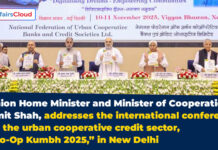 National Handloom Day is annually observed across India on 7 August to honour the handloom weaving community engaged in the handloom sector and highlight the handloom industry’s contribution to India’s socioeconomic development.
National Handloom Day is annually observed across India on 7 August to honour the handloom weaving community engaged in the handloom sector and highlight the handloom industry’s contribution to India’s socioeconomic development.
- 7th August 2025 marks the 11th National Handloom Day in India.
Exam Hints:
- Event: National Handloom Day 2025
- Observed on: 7 August 2025
- Edition: 11
- Theme:“Weaving Innovation into Tradition.”
- Why? To commemorate the Swadeshi Movement, launched on 7 August 1905.
- Supporting Bodies: MoT with NHDC
- Purpose: To generate awareness about handloom products and their importance in Indian culture.
- Events: Exclusive Handloom Expo, “Haat on Wheels” initiative etc.
- Awards: 5 Sant Kabir Awards & 19 National Handloom Awards
Background:
Origin: In 2015, the Government of India (GoI) declared August 7 as National Handloom Day, to commemorate the Swadeshi Movement and recognise the invaluable contribution of handloom weavers to the nation’s cultural and economic heritage.
First Observance: In 2015, the 1st National Handloom Day was inaugurated by Prime Minister (PM)Narendra Modi at the Centenary Hall of Madras University in Chennai, Tamil Nadu(TN).
- During the event, he also launched the India Handloom Brand (IHB) to brand high-quality handloom products with zero defects and zero effects on the environment.
Date Significance: The date of 7 August marks the launch of the Swadeshi Movement in 1905 to protest the British partition of Bengal and support the anti-partition movement.
- The key people involved in the Swadeshi movement include Bal Gangadhar Tilak, Lala Lajpat Rai, Bipin Chandra Pal, etc.
Significance of the Handloom Sector:
Role: The handloom sector is a vital source of livelihood in rural and semi-rural areas across India, supporting traditional skills and local economies.
Employment: The sector employs around 3.5 million people, including over 25 lakh women as weavers and allied workers that is 70% of the total workers.
- It plays a key role in women’s empowerment and financial independence in rural India.
Significance: Handloom weaving is the second-largest employment generator in India after agriculture.
Sustainability: Handloom production is eco-friendly, requiring minimal capital and power.
Global Market: In Financial Year 2024-25 (FY-25), the United States of America (USA)is the largest destination with Rs. 331.56 crore worth of exports followed by the United Arab Emirates(UAE) with Rs. 179.91 crore and the Netherlands with Rs. 73.88 crore of exports.
Government Initiatives for the Handloom Sector:
Key Initiatives: The GoI has introduced various initiatives to improve the handloom sector, including,
- Government e-Marketplace (GeM): To allow weavers to sell directly to the government departments’ marketplace.
- Raw Material Supply Scheme (RMSS): It is also known as Yarn Supply Scheme (YSS) which aims to support handloom weavers by ensuring the availability of quality yarn at affordable prices with 15% subsides on freight charges.
- Handloom Producer Companies: The government has formed 124 companies across states, aiding in the capacity building of 100 Producer companies.
- This initiative is formed in collaboration with the United Nations Development Programme (UNDP).
- Design Resource Centres (DRCs): These have been established in major cities to enhance design excellence in handlooms.
- Weaver MUDRA Scheme (WMS): This scheme offers financial assistance for working capital and new technology investments with recorded over 9,211 sanctioned loans in FY-25.
- Small Cluster Development Programme (SCDP): It focuses on providing need-based financial assistance upto Rs. 2 Crore per cluster.
- In FY-25, Over 79 clusters are sanctioned with total of Rs. 85.99 Crore under this scheme.
- Hathkargha Samvar: It aims to improve fabric quality and productivity through the adoption of upgraded looms, jacquards, dobbies, etc.
- Under the scheme, 90% of the Total manufacturing cost is borne by the Government of India(GoI).
Award initiatives: The Ministry of Textiles (MoT) has been annually conferring awards like the Sant Kabir Awards and the National Handloom Award for outstanding handloom weavers.
2025 Events:
Overview: The 11th National Handloom Day ceremony is celebrated on 7th August 2025 at Bharat Mandapam, New Delhi, Delhi. Droupadi Murmu, President of India, is the Chief Guest of the event.
Key Dignitaries: Union Minister Giriraj Singh (MoT) and Pabitra Margherita, Minister of State (MoS) for External Affairs & Textiles, were also present at this event.
Theme: The 2025 theme for 11th National Handloom Day is “Weaving Innovation into Tradition” and “My Handloom, My Pride; My Product, My Pride”.
Other Events: Other signature events include the “Haat on Wheels” initiative, Loom Hackathon by IIT Delhi, International Hand-woven Expo with Foreign buyers, exporters & handloom weavers, etc. as part of the event.
Books Launched: The President released the Award Catalogue and Coffee table book for this event, and Union Minister Giriraj Singh (MoT) officially launched the book “Carbon Footprint Assessment in the Indian Handloom Sector: Methods and Case Studies.”
Awards: The President conferred 5 Sant Kabir Awards with a cash prize of Rs. 3.5 lakhs and 19 National Handloom Awards with a cash prize of Rs. 2 lakhs to outstanding weavers in this event.
About “Haat on Wheels” initiative:
Overview: It is a mobile retail initiative launched by the MoT with the National Handloom Development Corporation (NHDC) to celebrate National Handloom Day 2025.
- It is launched alongside the Exclusive Handloom Sari Expo at Handloom Haat, Janpath, New Delhi, which showcases 116 distinct weaves from India.
Significance: The vehicle starts from Janpath, New Delhi and will journey across key public areas including markets, residential societies, and art zones.
About the National Handloom Development Corporation (NHDC):
Chairperson – Dr. M. Beena
Established- 1983
Headquarters- Uttar Pradesh, India



